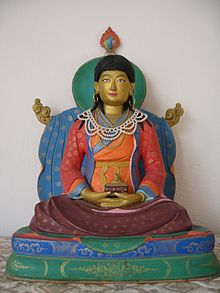Kunzang Dekyong Wangmo
Sera Khandro Kunzang Dekyong Wangmo | |
|---|---|
སེ་ར་མཁའ་འགྲོ་ཀུན་བཟང་བདེ་སྐྱོང་དབང་མོ། | |
 A statue of Sera Khandro | |
| Other names | Bde-baʼi-rdo-rje, mDo-med mkhaʼ-spyod, dBus-bzaʼ mkhaʼ-ʼgro kun- bzang bde-skyong dbang-mo |
| Personal | |
| Died | dbyi shod dpal gyi ri bo che |
| Religion | Buddhist |
| Nationality | Tibetan |
| Lineage | Nyingma |
| Other names | Bde-baʼi-rdo-rje, mDo-med mkhaʼ-spyod, dBus-bzaʼ mkhaʼ-ʼgro kun- bzang bde-skyong dbang-mo |
| Temple | Sera Tekchen Chokhorling[1] |
| Senior posting | |
| Reincarnation | Yeshe Tsogyal |
show
Students | |
Sera Khandro Kunzang Dekyong Wangmo (1892–1940) or Sera Kandro is considered an emanation of Yeshe Tsogyal, and in her lifetime was a Terton of Tibetan Buddhist Vajrayana, a biographer and autobiographer, and a highly respected teacher.[2][3] She taught Dudjom Rinpoche, Chatral Rinpoche, and the First Adzom Drukpa, , among other high lamas.[3]
Sera Khandro was born into a rich family, but ran away at the age of 14 to escape an unwanted engagement, and to follow the Vajrayana teacher , who was then in Lhasa on pilgrimage from Golok in Eastern Tibet.[4] She returned with him and his students to Golok, where she lived as a renunciate. There, Sera Khandro became life partners with .[3] [4]
Garra Gyelsel disliked her Terma revelations, and this caused Sera Khandro to become sick.[4] Her health returned when she left and returned to Drime Ozer with whom she subsequently revealed the specific treasure scriptures, or Terma, for which Sera Khandro is known.[4] From when she was young she had experienced visions of Vajravarahi and exhibited many confirming indications of being a treasure revealer, a Terton. This meant that Sera Khandro had karmic connections with hidden treasures of the Nyingma Terma lineage, and to those which concealed the Termas, eighth-century Vajrayana master Padmasambhava and his consort and Vajrayana master Yeshe Tsogyal.[4]
Sera Khandro was a teacher to many high Nyingma lamas, including Dudjom Jigdral Yeshe Dorje and Chatral Sangye Dorje.[4]
She is considered an emanation of Yeshe Tsogyal.[2]
In Sarah H. Jacoby's Love and Liberation: Autobiographical Writings of the Tibetan Buddhist Visionary Sera Khandro (New York: Columbia University Press, 2014), the author wrote Khandro was "one of the few Tibetan women to record the story of her life." Khandro also wrote the biography of her guru, ,[5] son of the Terton Dudjom Lingpa.
Books and academic articles[]
- (in English) Zangpo, Ngawang (2002). The Immaculate White Lotus in Guru Rinpoche: His Life and Times. Boulder: Shambhala Publications. p. 360. ISBN 978- 1559391740.
- (in English) Khandro, Sera (2014). Refining Our Perception of Reality: Sera Khandro's Commentary on Dudjom Lingpa's Account of His Visionary Journey. Shambhala Publications. p. 456. ISBN 978-0231147699.
- (in English) Jacoby, Sarah H. (2015). Love and Liberation: Autobiographical Writings of the Tibetan Buddhist Visionary Sera Khandro. Columbia University Press. p. 336. ISBN 978-1559394246.
- (in English) Jacoby, Sarah H. (2014). The Excellent Path of Devotion: An Annotated Translation of Sera Khandro's Short Autobiography, in Himalayan Passages: Tibetan and Newar Studies in Honor of Hubert Decleer. Boston: Wisdom Publications. p. 384. ISBN 978-1614290735.
- (in English) Jacoby, Sarah H. (2010) [2009]. "This Inferior Female Body:’ Reflections on Life as a Treasure Revealer Through the Autobiographical Eyes of Se ra mkha’ ‘gro (Bde ba’i rdo rje, 1892-1940) in” Journal of the International Association of Buddhist Studies 32/1-2 (2009/2010): pp. 115-150. (PDF).
- (in English) Jacoby, Sarah H. (2009). To be or not to be Celibate: Morality and Consort Practices According to the Treasure Revealer Sera Khandro’s (1892-1940) Auto/biographical Writings, in Buddhism beyond the Monastery: Tantric Practices and their Performers in Modern Tibet (PDF). Leiden: Brill. p. 202. ISBN 978-9004176003.
References[]
- ^ "Sera Tekchen Chokhorling". Treasury of Lives. Retrieved 2016-12-10.
- ^ Jump up to: a b Kurtis R. Schaeffer. "Sources of Tibetan Tradition". google.com.au (Google books). Retrieved 1 May 2015.
- ^ Jump up to: a b c "Biography: Sera Khandro Kunzang Dekyong Wangmo". [Treasury of Lives]. Retrieved 1 May 2015.
- ^ Jump up to: a b c d e f Alexander Gardner. "Treasury of Lives: Female Buddhist Masters". tricycle. Retrieved 22 September 2016.
- ^ Jacoby, Sarah Hieatt (2007). "Consorts and Revelations in Eastern Tibet : The Auto/Biographical Writings of the Treasure Revealer Sera Khandro (1892-1940)". UVA Library | Virgo. Retrieved 2017-08-06.
External links[]
- Sera Khandro: A Reader's Guide - article at Shambhala Publications
- Sera Khandro Kunzang Dekyong Wangmo - article at Treasury of Lives
- Rigpawiki
- Tibetan Buddhists from Tibet
- 1892 births
- 1940 deaths
- Female Buddhist spiritual teachers
- Tibetan women